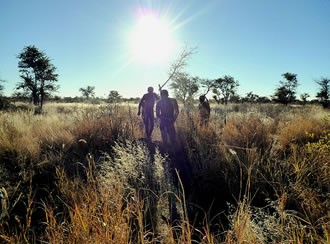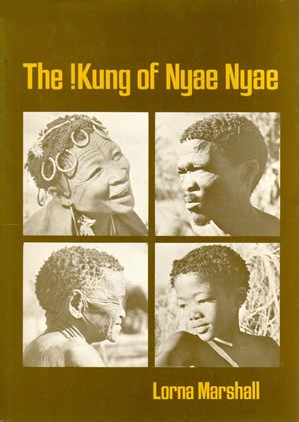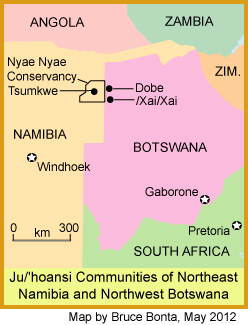Location. Also called the Ju/wasi and the !Kung, this San society of about 30,000 people live in the deserts of Botswana, Namibia, and Anglola, in southern Africa with a central, interior area on the Botswana/Namibia border (see map).

Economy. Most Ju/’hoansi (pronounced zhut-wasi) were nomadic hunters and gatherers until the latter part of the 20th century. Since they live in a very hostile desert environment, they had to keep moving in order to keep eating, since food and water resources are sparse. Unlike people in other arid regions, they did not have any periods of plenty and thus they had no way of storing food supplies. But since food shortages were likely to be localized, they reduced risk through widespread pooling networks and through the social solidarity of their local groups. In essence, the group’s peaceful cohesiveness was its stored surplus. Over the past 50 years, most Ju/’hoansi have settled into permanent communities where they farm, herd livestock, produce crafts, and do other work. A news report in 2012 describes the generally favorable current economic conditions of the Ju/’hoansi, and a 2013 news report explores how a severe drought can prompt Ju/’hoansi peacefulness.
Beliefs that Foster Peacefulness. //Gauwa, the lesser god, and the //gauwasi, the spirits of the dead, sometimes come to earth and interfere with human lives, causing accidents and sickness. The //gauwasi inspire fear but not terror: they can be bad, good, or indifferent, they sometimes feel pity toward humanity, and they respond to humans with both fortune and misfortune. Human social ills are thus the fault of people, not the gods, so humanity needs to address its own problems.
Avoiding and Resolving Conflict. Discussions of issues that might lead to conflicts, such as laziness, stinginess, or unfair distribution of meat are normally maintained at the level of gossip, open criticism, or humor. Occasionally, when both parties become angry, conversations escalate to the level of a “talk,” which is characterized by sudden, spontaneous, extravagant comments poured out at a rapid rate. If tempers flare, however, everyone tries to resolve the dispute before serious fighting erupts, but sometimes either a physical fight occurs or the group splits apart.
Gender Relations. Until recent decades, while the Ju/’hoansi still subsisted on hunting and foraging in the bush, everyone prized the meat that the men hunted but they really lived on the vegetable foods gathered by the women, which provided 60 to 80 percent of their diet. The women thus derived a lot of self-esteem from their contributions to their families. The vivacious, self-confident women foraged many miles from the men without weapons, despite the possibility of encountering large predators such as lions and leopards. They did not need permission from men or assistance from them in their food-production work. Men and women could be absent from the camps for days at a time, so there was no inequality with men being gone while women maintained the home. The Ju/’hoansi valued the sexes nearly equally.

Raising Children. The Ju/’hoansi rarely display aggression so their children have little opportunity to emulate aggressive behavior. Whenever children do exhibit signs of aggression, adults quickly intervene to diffuse their hostilities. They will take children away from a fight and try to distract them rather than lecture or punish them for fighting. When they used to live on the land, the close physical proximity of their huts—tightly clustered around central clearings—meant that children seldom got to play away from the ear of an adult, and aggression rarely had a chance to develop. In recent decades, these patterns have changed, of course, since most families now live in more permanent homes. Many Ju/’hoansi children now attend schools, but those schools have numerous problems, as a 2011 news story and another in 2015 reported.
Social Practices. Healing through trance dancing among the Ju/’hoansi is a routine part of their daily existence, a mark of their feelings toward one another, and an important element of support for their egalitarian culture.
- Trance Dances: At the all-night trance dances, the men dance around a circle of chanting, clapping women, who sometimes also join the dancing. As the dancing increases in energy, the n/um (energy) rises in the healers until they reach a state of !kia (altered consciousness) in which they can begin to cure physical and mental illnesses by laying their hands on the sick people and pulling out the sicknesses.
- Egalitarian Powers: The powers of the n/um are held by about 50 percent of the men and 10 percent of the women; their egalitarian ethic requires that it be shared as widely as possible.
- Social Benefits: The dance assists in the promotion of social cohesiveness, and mends the fabric of society by releasing hostilities. Healing may focus on individuals who are ill, but it also heals divisive issues and reunites the group into a greater spiritual union.
Cooperation and Competition. There are few children in a Ju/’hoansi band–perhaps 14 of both sexes ranging in age from infants to fourteen-year olds. Consequently, competitive games would be hard to organize since it would be difficult to find an age-mate to compete with, much less enough to form viable team sports. This accords with the Ju/’hoansi cultural opposition to competitiveness. While the children exhibit widely differing abilities in their games, they don’t compete: all play for the sheer pleasure of it.
 Sharing. The basis of their society is an absolute willingness to share everything, a practice that prevails generally among foraging groups of people. But even though they regard stinginess with great hostility, they are even more strongly opposed to arrogance. A hunter who announced his success to his camp, or a woman who made a point of displaying her gift to another is arrogant. They have elaborate leveling devices which include downplaying gifts, self-deprecating comments, rough humor, put-downs, and back-handed compliments. However, one researcher has found that beliefs in sharing only work if the giving is generally known: the Ju/’hoansi don’t give anonymously.
Sharing. The basis of their society is an absolute willingness to share everything, a practice that prevails generally among foraging groups of people. But even though they regard stinginess with great hostility, they are even more strongly opposed to arrogance. A hunter who announced his success to his camp, or a woman who made a point of displaying her gift to another is arrogant. They have elaborate leveling devices which include downplaying gifts, self-deprecating comments, rough humor, put-downs, and back-handed compliments. However, one researcher has found that beliefs in sharing only work if the giving is generally known: the Ju/’hoansi don’t give anonymously.
Strategies for Avoiding Warfare and Violence. Camp compositions of the Ju/’hoansi are quite flexible; territorial boundaries are vaguely defined and not defended. The environmental reason for this flexibility is the wide variation in annual rainfall in any given location. The ability of people to move to another area which has had greater rainfall ensures survival for all. They have no living memory of fighting over territories.
But How Much Violence Do They Really Experience? Lee (1979) argues that the Ju/’hoansi have a relatively violent society. During his three years of living among them, he recorded 58 arguments, of which 34 led to physical fights. He acknowledges that he differs from other perceptions of them as peaceful, such as those of Thomas (1994), who argues that when she and her family were observing them during the 1950s, they heard about very few episodes of violence. Thomas and other scholars felt that Ju/’hoansi cultural stability was based on their successful adaptation to their environment plus their normal spirit of cooperation. Peacefulness appeared to be strongly fostered by their social system, their methods of suppressing aggression, and the ways they developed their self-control. There is little doubt that larger communities formed at permanent water sources, such as Tsumkwe in Namibia, provide few incentives for maintaining traditional social patterns and control structures. Many people are only marginally employed, and ready access to alcohol has fostered severe problems, including violence. Nevertheless, the various ways the Ju/’hoansi strove to retain their peacefulness are well worth careful study. A tragic homicide in a Ju/’hoansi community in 2012 reinforces the importance of these issues.
Scholarly Resources in this Website:
- “‘The Old People Give You Life’: Aging among !Kung Hunter-Gatherers.” (Biesele and Howell, 1981)
- “!Kung Women: Contrasts in Sexual Egalitarianism in Foraging and Sedentary Contexts.” (Draper, 1975)
- “Social and Economic Constraints on Child Life among the !Kung.” (Draper, 1976)
- “Room to Maneuver: !Kung Women Cope with Men.” (Draper, 1992)
- “Politics, Sexual and Non-Sexual in an Egalitarian Society.” (Lee, 1978)
More Resources in this Website:
- The Ju/’hoansi used to build social harmony through storytelling around a campfire.
- The Ju/’hoansi effectively manage their social, cultural, and economic conditions—see a book review in October 2013.
- The importance of preserving and strengthening the Ju/’hoansi native language was reported in February 2014.
- Ju/’hoan skill as trackers assisted German scientific research about the movements of early Europeans in the caves they visited.
- The Ju/’hoansi anticipate global climate changes and take appropriate action.
- The peaceful Ju/’hoansi mistreat their dogs.
Sources in Print: Biesele and Hitchcock 2013; Biesele and Royal-/o/oo 1999; Draper 1973, 1975, 1976, 1978, 1992; Katz 1982, 1983; Lee 1972, 1978, 1979, 1993; Marshall 1962, 1976, 1999; Rosenberg 1990; Thomas 1959, 1994; Wiesner 1982
Sources on the Web: The Ju/’hoansi Development Fund; Kalahari Peoples Network; Pfaffe 2003; Wikipedia (English Version);
Updates—News and Reviews:
Selected Recent Stories
October 1, 2015. Ju/’hoansi Confront Climate Change
June 4, 2015. The President Visits the Ju/’hoansi
April 30, 2015. Ju/hoan Man Appointed to Government Position
December 12, 2013. Ju/’hoansi Community Forest Threatened
All Stories
All stories in this website about the Ju/’hoansi are listed in the News and Reviews Subject Listing
